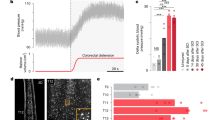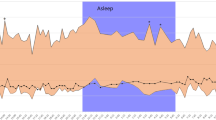Abstract
Study design:
Case report.
Objectives:
To describe two cases of hardware failure with pseudoarthrosis causing autonomic dysreflexia. The first patient was a 24-year-old woman with T3 ASIA (American Spinal Injury Association)-A paraplegia who developed complete failure and breakage of the Luque rods at the T11-12 region. The second woman was a 36-year-old T5 ASIA-A complete paraplegic who fractured her Harrington rods at T12 and L1 bilaterally.
Setting:
Saskatoon City Hospital, Saskatchewan, Canada.
Methods and results:
Both patients underwent operation for surgical fixation. In both cases, stabilization and fusion of the spinal deformity abolished the autonomic dysreflexia.
Conclusion:
Owing to the failure of spine-stabilizing hardware, sitting upright may cause an afferent stimulus that triggers the onset and worsening of symptoms associated with autonomic dysreflexia. Therefore, in contrast to current acute treatment regimes, lying down may be preferred to sitting upright (to decrease blood pressure) as a means to relieve the afferent stimulus. Surgical correction and hardware replacement alleviated the symptoms in these two patients.
Similar content being viewed by others
Log in or create a free account to read this content
Gain free access to this article, as well as selected content from this journal and more on nature.com
or
References
Consortium. Acute Management of Autonomic Dysreflexia, 2nd edn. Paralyzed Veterans of America: Washington, DC, 2001.
Beard JP, Wade WH, Barber DB . Sacral insufficiency stress fracture as etiology of positional autonomic dysreflexia: case report. Paraplegia 1996; 34: 173–175.
Graham GP, Dent CM, Evans PD, McKibbin B . Recurrent dislocation of the hip in adult paraplegics. Paraplegia 1992; 30: 587–591.
Mohit AA, Mirza S, James J, Goodkin R . Charcot arthropathy in relation to autonomic dysreflexia in spinal cord injury: case report and review of the literature. J Neurosurg Spine 2005; 2: 476–480.
Yin KS, James J, Lew K, Little JW . Refractory heterotopic ossification with complications. J Spinal Cord Med 2001; 24: 119–122.
Author information
Authors and Affiliations
Corresponding author
Rights and permissions
About this article
Cite this article
Li Pi Shan, R., Linassi, A., Dzus, A. et al. Hardware failure and spinal pseudoarthrosis causing autonomic dysreflexia: a report of two cases. Spinal Cord 47, 899–900 (2009). https://doi.org/10.1038/sc.2009.51
Received:
Revised:
Accepted:
Published:
Issue date:
DOI: https://doi.org/10.1038/sc.2009.51



